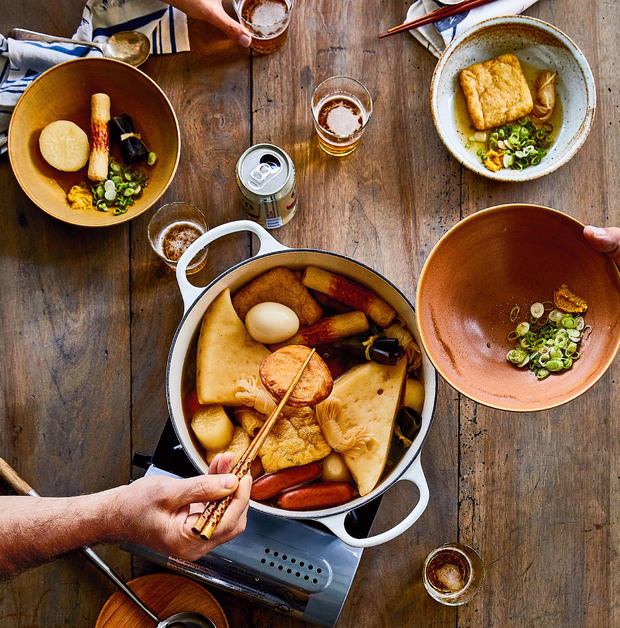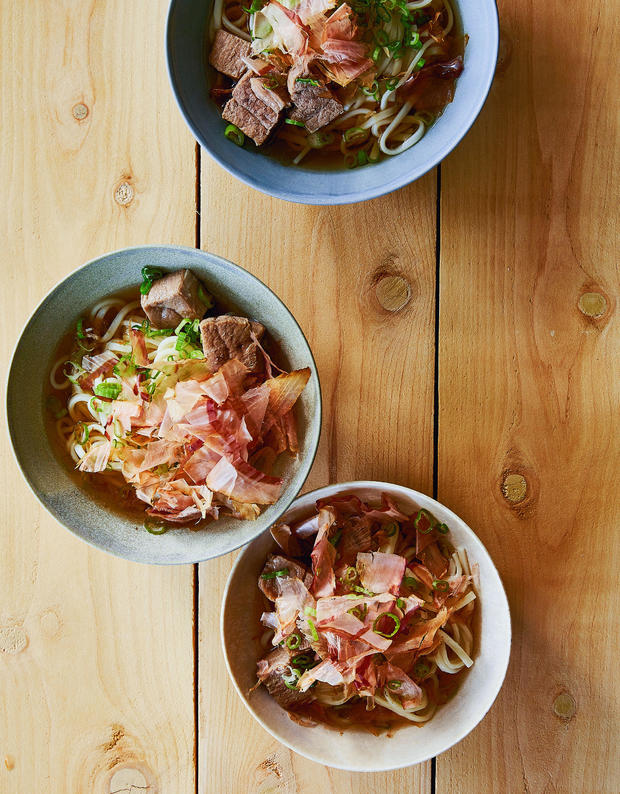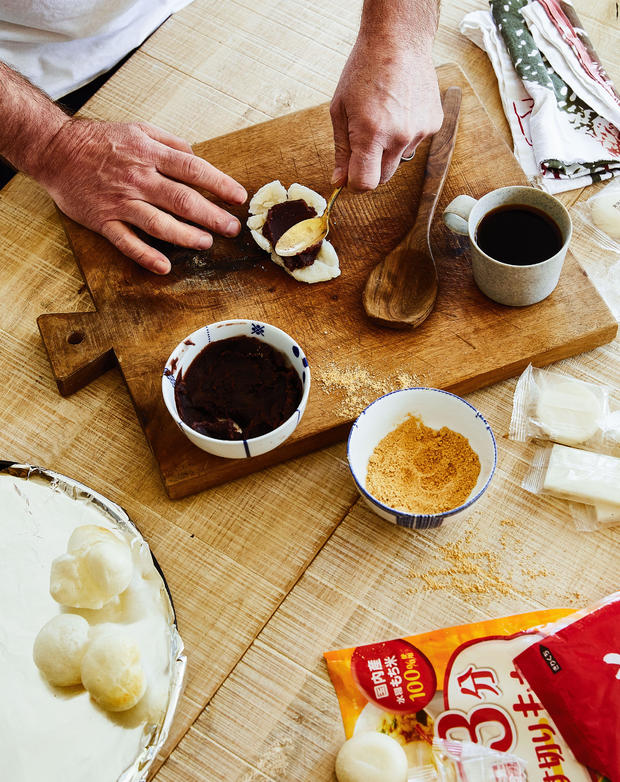The Dish: Chef Ivan Orkin shares Japanese recipes
Chef Ivan Orkin's first exposure to Japan was a lowly one, washing dishes in a Long Island sushi bar when he was just 15. But he fell in love with the cuisine and the culture. After restaurant work in the United States, he moved to Tokyo and took his wife's bold suggestion to open a ramen shop.
The unlikely gamble paid off. His Ivan Ramen became a hit and spawned two locations now open in New York City. He's also co-author of "The Gaijin Cookbook: Japanese Recipes from a Chef, Father, Eater, and Lifelong Outsider."
Here are some of his recipes.
Oden Party (serves 4 to 6)
Broth ingredients:
- 8 cups Dashi (see below)
- 3 tablespoons soy sauce
- 3 tablespoons sake
- 3 tablespoons mirin
Packaged ingredients (choose three or four):
- 12 ounces (2 packages) shirataki noodles
- Chikuwa (cylindrical fish cakes), left whole
- Satsuma-age (fried fish cakes), left whole
- Abura-age (fried tofu)
- Hanpen (white fish cakes), cut into triangles or smaller squares
- Japanese (arabiki) sausages (or hot dogs or Vienna sausages)
- Kombu maki (dried seaweed rolls), soaked in hot water for 5 minutes
Fresh ingredients:
- 12 ounces daikon, peeled and sliced into ½-inch-thick rounds
- Optional: 4 large eggs or soy-marinated eggs (Ajitama) (see below)
For the broth, add the dashi, soy sauce, sake and mirin to a large pot or Dutch oven set over medium heat and bring to a bare simmer. Meanwhile, if using shirataki noodles, rinse them in a colander in the sink with cold water, then pour 2 cups boiling water over them to help remove any funky odor. Begin adding ingredients to the simmering broth in the order of their cooking times (see below), longer-cooking items. Keep the heat at a bare simmer and work in batches if necessary. With the exception of the daikon and eggs, you're not trying to cook anything, per se. You're mostly reheating and infusing dashi flavor into precooked foods. Distribute bowls and serve people one or two pieces at a time with a splash of broth, a smear of mustard, and a handful of green onions on the side.
Oden ingredient cooking times:
Abura-age: 5 minutes
Shirataki Noodles: 10 minutes
Hanpen: 5 minutes
Japanese sausages (or hot dogs or Vienna sausages): 10 minutes
Satsuma-age: 5 minutes
Eggs: 15 minutes; peel, then return to the pot for 5 to 10 minutes
Daikon: 40 to 50 minutes
Kombu maki: 10 minutes
Dashi (makes about 7 cups)
Ingredients:
- One 5-x-10-inch sheet kombu
- 4 cups tightly packed katsuobushi (bonito flakes)
Bring 8 cups water to a bare simmer in a large saucepan, then shut off the heat and add the kombu. Let the seaweed sit for 5 minutes, then add the katsuobushi, cover the pan, and allow to soak for 15 more minutes. Strain the broth through a fine-mesh strainer and let cool. Use immediately, or pack up and store. The dashi will keep for 2 days covered in the fridge or for a couple months if you freeze it into ice cubes and store them in a zip-top bag with the air squeezed out.
Soy-marinated eggs (Ajitama) (makes 5 eggs)
Ingredients:
- 5 large eggs
- 1 cup mirin
- 1 cup sake
- 1 cup soy sauce
- 2 tablespoons sugar
- ½ cup tightly packed katsuobushi (bonito flakes)
Bring a medium saucepan of water to a boil. Carefully lower in the eggs with a slotted spoon or strainer and cook for 7 minutes and 15 seconds (set a timer), then immediately lift them out and plunge into an ice bath. Let the eggs cool completely. Meanwhile, bring the mirin, sake, soy sauce, and sugar to a simmer in a saucepan, stirring to dissolve the sugar. Shut off the heat and add the katsuobushi. Allow to steep for 10 minutes, then strain and cool the liquid. Crack and peel the eggs and place in a large zip-top bag. Add the cooled liquid and seal. Refrigerate for a minimum of 12 hours before serving. After 24 hours, remove the eggs from the brine and store in the fridge for up to a few days longer.
Tempura Party (serves 4)
Ingredients:
Firm vegetables (choose a couple)
- Carrots, peeled and cut on the bias into ¼ -inch-thick slices
- Lotus root, peeled and sliced into ¼ -inch-thick-rounds
- Kabocha squash, quartered, seeded, and sliced into ¼ -inch-thick crescents
- Sweet potato, peeled and sliced into ¼ -inch-thick rounds
- Onion, peeled and sliced into ½ -inch-thick rounds and separated into rings
Soft vegetables (choose a couple)
- Maitake, shimeji (beech), or oyster mushrooms, trimmed and torn into finger-size chunks
- Shiitake mushrooms, stems removed
- Asparagus, woody bottoms removed, peeled, and sliced in half
- Chrysanthemum or dandelion greens, torn into 2-inch pieces
- Okra (whole)
- Zucchini, sliced on the bias into ½ -inch-thick pieces
Seafood
- Medium or large shrimp, peeled but tail left on (give the back of each shrimp a couple light whacks against a cutting board to break up the muscle fibers and prevent them from curling as they cook)
- Squid bodies, sliced into rings
4 to 6 quarts vegetable oil for deep-frying
For the batter:
If you want more batter than this, make it in batches. Don't try to double or triple the recipe. This batter is extremely light, not like what you'll find at most Japanese-American restaurants. It will give the seafood and vegetables a gossamer-thin coating of crunchiness.
- 2 large egg yolks
- 1.25 cups cake flour, sifted
- For serving
- Tempura Dipping Sauce (see below)
- Ten Don Sauce (see below; optional)
- Steamed rice
Have the vegetables and/or seafood at the ready. Add the vegetable oil to an 8- to 10-quart heavy-bottomed pot. (If you have a deep fryer, more power to you.) Heat the oil to 350 degrees over medium heat, using a deep-fry thermometer to check the temperature. Line a baking sheet with paper towels or a wire rack to receive the fried items. For the batter, it's important that the water be very cold, so begin by making a couple cups of ice water, then straining and measuring out 1.75 cups. Pour the water into a bowl, add the egg yolks, and whisk thoroughly to combine. Add the flour and whisk very lightly. Resist the urge to overmix. It's fine if a few lumps remain, and you will be rewarded with an airy, lattice-like tempura. Meanwhile, set your guests up with individual bowls of sauce(s) and rice, if you're serving it.
Once the oil is hot, start with whichever ingredient you like. Give it a quick dip into the batter, using your fingers or wooden chopsticks, then give it a little shake to let any excess drip back into the bowl. Lower the battered ingredient into the oil and give it a gentle stir. Most items will take somewhere around 90 seconds to cook through and crisp up, but you'll want to test a piece of each one to get the timing right first. Never fry so many items simultaneously that the oil temperature drops dramatically. Remove the fried items from the oil and let drain for a few seconds, then serve while still hot and crisp.
Tempura dipping sauce (makes 1.5 cups)
Ingredients:
- 1 cup Dashi
- ¼ cup soy sauce
- ¼ cup mirin
- ½ cup finely grated daikon
Combine the dashi, soy sauce and mirin in a bowl, then divide among individual dipping bowls. Set out the grated daikon in a separate bowl so diners can add a couple tablespoons or so to taste.
Ten don sauce (makes 1.5 cups)
Ingredients:
- 4 cups Dashi
- ¾ cup soy sauce
- ½ cup mirin
- 2 tablespoons sugar
Combine the dashi, soy sauce, mirin and sugar in a saucepan and bring to a simmer over medium heat, stirring to dissolve the sugar. Cook until the liquid is reduced by about 75% and the sauce is syrupy, about 9 minutes. Cool and store in the fridge for up to a week. Serve cool or at room temperature.
Okinawa-style soba with pork belly and katsuobushi (Soki Soba) (serves 2 as a main dish, 4 as an appetizer)
Ingredients:
- 10 ounces skinless pork belly, cut into 1-inch cubes
- 4 scallions, white and light green parts sliced into 2-inch lengths, dark green parts sliced thin for garnish
- One 2.5-inch piece ginger, peeled and sliced thin
- 3 tablespoons soy sauce
- 3 tablespoons sake
- 1 tablespoon sugar
- Kosher salt
- ½ cup tightly packed katsuobushi (bonito flakes), plus more for garnish
- 6 ounces dried udon
Combine the pork belly, white and light green scallion parts, ginger, 2 tablespoons of the soy sauce, the sake, sugar and 4 cups water in a medium saucepan and bring to a simmer over medium-high heat. Drop the heat to low and simmer for 1 hour and 15 minutes, or until the pork is tender; replenish with water as necessary to maintain the same amount of liquid, about a half cup every half hour. Use a slotted spoon to scoop the meat out of the liquid. Strain the broth, return to the pot, then add the remaining 1 tablespoon soy sauce and season to taste with salt. Add the katsuobushi and let it stand for 10 minutes. Meanwhile, cook the udon according to the package directions. Divide the noodles into two or four bowls. Strain the broth and ladle it over the noodles, then top each with a few pieces of pork belly, sliced scallion greens, and a big pinch of katsuobushi.
Grilled peppers with ginger-onion shio tare (serves 4 to 6 as an appetizer)
Ingredients:
- ½ cup plus 1 tablespoon vegetable oil
- ½ onion, finely diced
- 4 garlic cloves, minced
- 1 1-inch piece ginger, peeled and minced
- 1 to 2 teaspoons fine sea salt
- 3 bell peppers (or 12 to 15 small, sweet peppers) of various colors
For the shio tare, combine the oil, onion, garlic and ginger in a small heavy-bottomed saucepan, set over low heat and cook for about 20 minutes, stirring occasionally, until the onion has softened and barely begun to brown. Remove the pan from the heat and add 5 tablespoons water and 1 teaspoon salt, stirring to dissolve the salt. Cool to room temperature, then taste and decide whether or not to add more salt. Prepare a medium fire in an outdoor grill or preheat the oven to 400 degrees. If you're using large peppers, stem them, remove the seeds and slice into quarters. Grill over medium heat or roast on a baking sheet, turning occasionally, until the skins have begun to blacken in places and the flesh is tender but not completely limp, about 20 minutes. Arrange the peppers on a plate and top generously with the shio tare. Serve warm.
Rice cakes (mochi) (makes as many as you like)
Ingredients:
- Kiri mochi (hard rectangles or rounds of packaged mochi)
Heat the mochi in one of three ways. Mochi is like napalm when it gets hot and drippy, so be very careful.
- In an oven (or toaster oven): Heat the oven to 425 degrees. Lay the mochi on a baking sheet, or directly on the oven rack, if it won't slip through, and bake until the mochi puffs up and begins to turn golden, usually 5 to 8 minutes. Remove carefully.
- On a grill rack set over a low flame: If you happen to have a small wire grate that fits over your gas range, you can grill a piece of mochi for about 2 minutes over very low heat, flipping it often, until it puffs up and begins to turn golden. Remove carefully.
- In a microwave: This is not the most desirable method because you won't get any crispness, but if you gotta have your mochi in a hurry, place it on a heatproof plate and microwave for about 20 seconds on high power, until it puffs and softens.
Then add the accoutrements. Pick one route, or throw a choose-your-own-mochi party by setting out the various options. All of these ingredients are readily available at Japanese markets and online.
- Filled with sweet red bean paste: Place a warm piece of mochi on a cutting board and use a spatula (or your palm, if you're feeling daring) to smash it flat. Place 1 tablespoon sweet red bean paste (anko) in the center of the mochi and wrap the mochi around it. Use your fingers to seal the cake, and enjoy.
- Dusted with kinako (toasted soy flour): For each piece, mix together 1 tablespoon kinako and 2 teaspoons sugar in a small bowl. Use a pair of chopsticks to dunk a warm piece of mochi into a cup or bowl of warm water, then immediately drop the mochi into the kinako mixture. Stir it around to coat, then gobble it up.
- Wrapped in nori and dipped in soy sauce: For each piece, mix together 2 tablespoons soy sauce and 1 tablespoon mirin in a small bowl. Wrap a piece of warm mochi in a quarter sheet of nori and dip it into the sauce as you eat. (If you like, you can toast the nori over an open flame first.)








